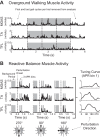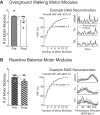Increased neuromuscular consistency in gait and balance after partnered, dance-based rehabilitation in Parkinson's disease
- PMID: 28381488
- PMCID: PMC5501921
- DOI: 10.1152/jn.00813.2016
Increased neuromuscular consistency in gait and balance after partnered, dance-based rehabilitation in Parkinson's disease
Abstract
Here we examined changes in muscle coordination associated with improved motor performance after partnered, dance-based rehabilitation in individuals with mild to moderate idiopathic Parkinson's disease. Using motor module (a.k.a. muscle synergy) analysis, we identified changes in the modular control of overground walking and standing reactive balance that accompanied clinically meaningful improvements in behavioral measures of balance, gait, and disease symptoms after 3 wk of daily Adapted Tango classes. In contrast to previous studies that revealed a positive association between motor module number and motor performance, none of the six participants in this pilot study increased motor module number despite improvements in behavioral measures of balance and gait performance. Instead, motor modules were more consistently recruited and distinctly organized immediately after rehabilitation, suggesting more reliable motor output. Furthermore, the pool of motor modules shared between walking and reactive balance increased after rehabilitation, suggesting greater generalizability of motor module function across tasks. Our work is the first to show that motor module distinctness, consistency, and generalizability are more sensitive to improvements in gait and balance function after short-term rehabilitation than motor module number. Moreover, as similar differences in motor module distinctness, consistency, and generalizability have been demonstrated previously in healthy young adults with and without long-term motor training, our work suggests commonalities in the structure of muscle coordination associated with differences in motor performance across the spectrum from motor impairment to expertise.NEW & NOTEWORTHY We demonstrate changes in neuromuscular control of gait and balance in individuals with Parkinson's disease after short-term, dance-based rehabilitation. Our work is the first to show that motor module distinctness, consistency, and generalizability across gait and balance are more sensitive than motor module number to improvements in motor performance following short-term rehabilitation. Our results indicate commonalities in muscle coordination improvements associated with motor skill reacquisition due to rehabilitation and motor skill acquisition in healthy individuals.
Keywords: dance; electromyography; exercise; muscle coordination; muscle synergy.
Copyright © 2017 the American Physiological Society.
Figures






References
-
- Berg K, Wood-Dauphinee S, Williams JI. The Balance Scale: reliability assessment with elderly residents and patients with an acute stroke. Scand J Rehabil Med 27: 27–36, 1995. - PubMed
Publication types
MeSH terms
Grants and funding
LinkOut - more resources
Full Text Sources
Other Literature Sources
Medical
Miscellaneous

